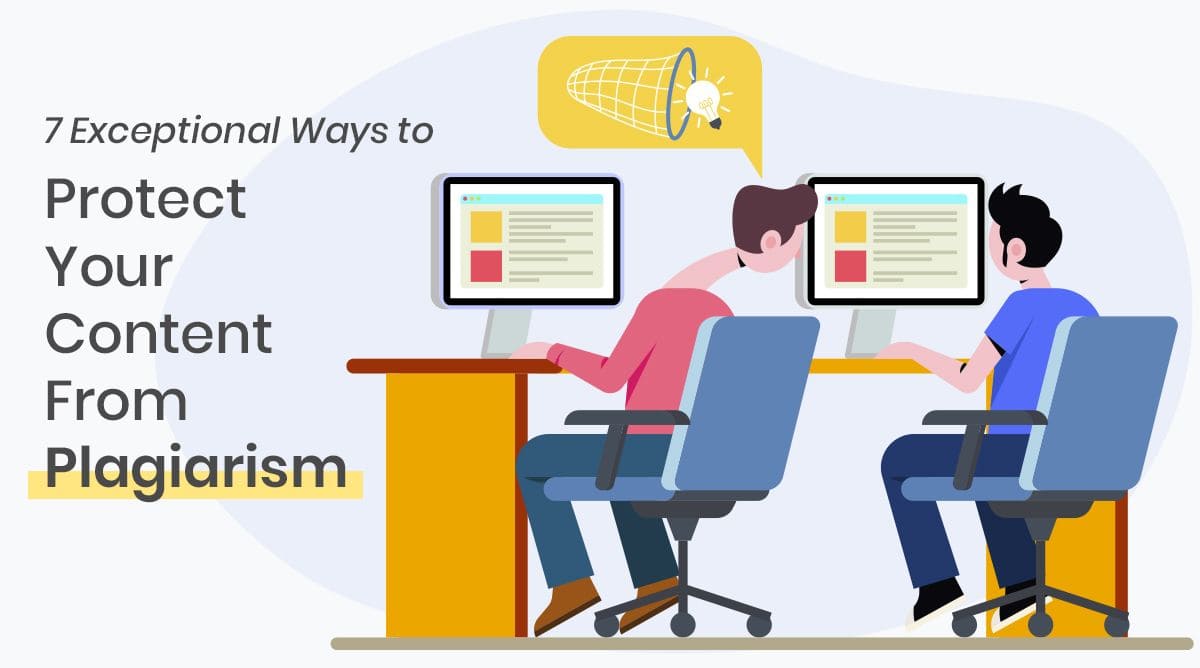Each and every person has the right to express what they think or feel, but not everyone is blessed with the skill to pen it down in a convincing way. If you have that creative mind and have written something worth posting and sharing, then it has high chances of getting stolen by people who may misuse your content without giving you any credit as its author.
In today’s world when everything is easily accessible over the internet, your creative piece of work can be easily copied and cited at any other place without you having any knowledge about it. So, the trick is to post your work on the web and protect content from plagiarism. This will allow you to share your knowledge with the world while preventing content thieves from stealing your ideas and getting its credit that they don’t deserve.
Table Of Content
Few effective ways to prevent your content from being stolen and plagiarized:
1. Add a JavaScript or HTML Code
Add a JavaScript or HTML code in your web pages during the web development stage. BY doing the you will enable the visitors to only read your content, but they will not be able to copy or download it. Although there are methods to still copy content with this code, it will be difficult and time-consuming for the plagiarists and it will need some technical know-how too. So, adding this code in your content will disable the ‘copy’ option, thereby making it difficult for others to use it without your permission.
2. Disable The Right Click Option
Plagiarists can steal not only your text content but your images, audio and video files too. In most web pages, these media files can be easily copied and saved by right clicking on them. Then the plagiarists can easily post them at their discretion without your permission. One possible solution for this problem would be to lock the right click option altogether on your web pages. When the users will be restricted from right clicking on your files, they won’t be able to copy and save them either.
There are options to lock the Ctrl+A and Ctrl+C options too so that no one will be able to select and copy your content using their keyboards either.
3. Include Warning In Your Web Page
Dedicate a few lines in your web content to declare a warning against copyright. Clearly state that if anyone copies, quotes, or re-posts your content; they will be legally liable for strict action. Also, announce that usage of your creative content in any form will require your permission and that you must be duly credited for it. While rules are meant to be broken and any potential stealer will rarely pay heed to your warning, posting such warnings will discourage them, and you will have a stronger stand while making a legal claim.
4. Use Your Unique Writing Style
Every writer upholds the rights of content originality protection. This often becomes their signature style of writing and anyone can easily guess that it is written by whom. Therefore, using unique words and phrases, sometimes photos, videos and sounds too, can give you ownership of the content and limit the chances of plagiarism.
5. Use Plagiarism Checking Tools
You can make use of the online plagiarism tools like SmallSEOTools and Copyscape for checking plagiarism and errors in a file. When you check some content using an online plagiarism checker, the tool browses through all the available data on the internet and looks for copied words and phrases. It can also be a great tool to check grammar, spelling and sentence structure errors in the content.
6. Use The Free Google Alerts Tool
Google is one of the most popular search engines that most web users rely on. However, apart from using it to browse through the internet, and send and receive emails, you can also use it to check the plagiarism of your creative content. Google allows you to set up free Google Alerts, after which you will receive an email whenever a copy of your original content is posted on a webpage. This tool uses special systems to compare your content with other web pages and look for copied words and phrases.
When you receive an email from Google Alerts tool, you can go to that page and see if your content is actually copied and misused. Once you confirm that, you can request its owners to either delete the copied content or give you the due credits.
7. Add Permanent Attribution to Your Web Page Code
While making your web page code, ask the webmaster to add your name, branding and other details all over your content and files. With this, others will not be prevented from copying your content, but whenever they do that, your permanent attribution will also be copied, and they won’t be able to remove it unless they delete your copied content too.
Is It Possible to Follow Plagiarism Prevention Strategies?
The steps mentioned above are highly effective in keeping your content safe from being stolen and preventing plagiarism to a great extent. All of them are proven and have been successfully used by content creators to deter content thieves away from your work. But still, if you have written valuable content, then plagiarists will find it attractive and they will do all that they can to steal it and use it in their work.
Despite being illegal, a large amount of content and thousands of images, audios, and videos are stolen every day without any attribution to the original creators. Therefore, the best way is to keep an eye on the usage of your work and quickly identify any theft or misuse. Whenever your content gets posted or copied anywhere else, a plagiarism checking software can detect that and alert you. It can also find out who stole your content and give you their details so that you can approach them and negotiate the next action. You can ask them to either delete your original content or give you the rightful credits on their web page.
You are the sole creator of your original work. It takes a lot of time, effort and brainpower to create something valuable. So, you should do everything in your capacity to keep it safe from theft. It is your right to be properly attributed to your content, and if you allow someone to use your content, you should be duly paid for that and you should receive the credits for your content as well. If that doesn’t happen, you are legally eligible to file a claim against the content thief, and seek your rights. Stealing content is also a kind of theft, and you can file a criminal case against the perpetrator.
Your original content is precious and you can easily protect it with some useful measures given in this article. You have taken great efforts at crafting engaging and bespoke content now you need to go ahead and protect its authenticity!
As an online creator, you need to consider protecting your content. The use of plagiarism checkers, copyright registration, and image watermarks is one of the strategies that help mitigate the chances of content theft. Online content protection is intellectual diligence. It is better to take the necessary preventative steps rather than waiting to reverse the damage of your work being stolen.
Although plagiarism can never be eliminated, the application of these seven strategies will offer a substantial form of protection. Taking action empowers you, allowing content creation theft to be discouraged in an easily actionable manner. Moreover, should the need to take legal action arise, your documentation will offer you a straightforward process.
FAQs
Is unintentional plagiarism equally harmful?
Even if you did not intend to commit plagiarism, it can damage your reputation professionally, and academically, as the damage is done through the unauthorized copying of someone else’s work, irrespective of intent.
How to properly cite sources when creating content?
Citing sources appropriately requires one to follow a certain citation format to give proper credit to the respective author and adequately incorporate them in the body of your text and in a reference list.
Can I legally protect my content before publishing it?
Your work can legally be shielded from infringement by the time it is published if it is registered with the copyright organizations, as this creates a public record and bolsters your legal position in the event of infringement.
Is adding a copyright notice to my website sufficient protection?
Although a copyright notice serves as public proof of ownership, it does not provide legal protection as strong as registration with regulation authorities.















